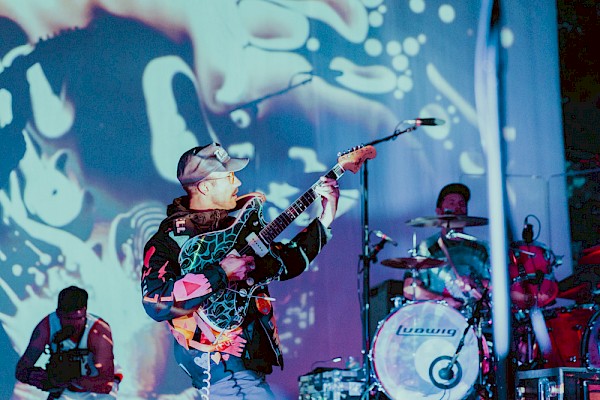 "Portugal. The Man won a Grammy last year for 'Feel It Still,' the epitome of a monolithic, fantastically beautiful melody. Like all of the songs that resonate with us collectively, it is the ultimate block," author Jamie Mustard says. Click to see more photos by Sydnie Kobza.In a world that’s overloaded with content, how do you get someone to stop and pay attention to your music? Fortunately, Jamie Mustard might have a solution.
"Portugal. The Man won a Grammy last year for 'Feel It Still,' the epitome of a monolithic, fantastically beautiful melody. Like all of the songs that resonate with us collectively, it is the ultimate block," author Jamie Mustard says. Click to see more photos by Sydnie Kobza.In a world that’s overloaded with content, how do you get someone to stop and pay attention to your music? Fortunately, Jamie Mustard might have a solution.
“I’ve seen so many musicians who want to be noticed, they want to be signed, but they aren’t using melodies,” Mustard says. By melody, he means “the sequence of single notes that are catchy and musically satisfying,” like the anthemic da, da da-da-da, daah daah of “Seven Nation Army” by The White Stripes or the twinkling keys that open Elton John’s “Tiny Dancer.” “What [many musicians] may not realize is: Melody is why we pay attention to music in the first place.”
Mustard’s a communications expert and art director in Portland, and he’s consulted with world-renowned artists, executives, brands and innovators. Yet he’s known to many as “The Iconist” due to his longtime obsession with one question: Why do we pay attention to certain things, while others are instantly forgotten? And not long ago, he stumbled across his answer: blocks.
“A block is a bold, repetitive, monolithic object so large and simple that we can’t help but notice it, on a primal level,” says Mustard, whose upcoming book The Iconist delves into “the art and science of standing out.”
“When done correctly, a block magnetizes our attention—if only for the briefest moment—and draws us in to hear the deeper message.”
Blocks come in many forms—an image, statement, physical structure, a piece of design. And in the world of music, they come in the form of melodies.
When speaking of melody, legendary producer Quincy Jones once said, “It’s clothed by lyrics, but melody is God’s voice. That’s the power.” That’s because melody—“a set of notes with the beauty and simplicity of a nursery rhyme,” as defined by Mustard—is the element of music that catches us by surprise. It’s the artist’s raw, defining message and what gives the song its originality. As a result, it permeates us as listeners, eliciting an emotional response that’s beyond our control. “Melody is what grabs us by the throat and pulls us into a song,” Mustard says. “It anchors and tethers us to the composition. It’s what takes us over and it’s what keeps us coming back.”
Consciously or not, some of music’s most iconic figures have employed block-like melodies. Beethoven, Michael Jackson, Billy Joel and Radiohead are prominent examples, as are hometown heroes like The Dandy Warhols and Portugal. The Man.
![]() Portland author Jamie Mustard's new book 'The Iconist: The Art and Science of Standing Out' is available October 1—pre-order it nowYet the issue is that, even if Mustard hears a melody these days, it’s often muddied and buried within the song. Or even worse, he’ll hear it once and then it goes away—the tension from which, he points out, can actually repulse people.
Portland author Jamie Mustard's new book 'The Iconist: The Art and Science of Standing Out' is available October 1—pre-order it nowYet the issue is that, even if Mustard hears a melody these days, it’s often muddied and buried within the song. Or even worse, he’ll hear it once and then it goes away—the tension from which, he points out, can actually repulse people.
The solution, then, seems simple: dominant, instantly recognizable hooks that repeat over a complex composition. “Any more complicated than a nursery rhyme, it’s not a melody,” he says. “And if it sounds pretty without the rest of the music, then you know you have it.”
But ultimately, as Mustard will adamantly say, a block’s only a tool. “Like how a painter uses a paintbrush,” he says.
After all, it’s our message that’s being revealed—our deepest, purest artistic expression. The block—or melody—is simply the mechanism to ensure our message gets an audience, that people will lock on and listen to the rest of the song.
By its nature, melody demands that the music is focused and distilled; an effective melody is succinct, simple and musically satisfying. Then, the rest is straightforward: We amplify it and make it larger than life. We bring it to fruition and repeat it with confidence, over and over and over—until the world can’t help but notice. Until it’s whistled in the streets, chanted by the masses, an anthem of our times.
Until it becomes iconic.








